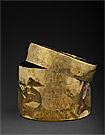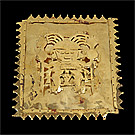Exhibition themes Sicán-Lambayeque
Sicán culture developed on the north coast in the Lambayeque Valley. It flourished for more than six centuries until defeated by the neighbouring Chimú Kingdom about 1375, after a spate of natural disasters led to the populace overthrowing their rulers. Sicán means ‘temple of the moon’ and is the indigenous name for the major site associated with the culture, Batán Grande in the La Leche Valley.
This ceremonial centre was established as a funerary–religious precinct between 900 and 1100 AD. It was the focus of a large religious state supported by intensive irrigation agriculture in nearby valleys. Batán Grande has many adobe pyramids and temples with shaft tombs for the Sicán elite, whose graves contained extraordinary numbers of gold objects.
Most remarkable is the metallurgy of the Sicán artisans. They worked with copper, gold and silver, sometimes combining the metals in varying quantities to produce tumbaga alloys. Tumbaga was especially suited to the process of annealing and thus metalworkers were able to make sheets as thin as 0.1 millimetre. Sicán smiths decorated their objects by embossing and die stamping, and soldered decorative elements to their precious ceremonial and grave goods. The richness and luxury of their belongings, and their advanced skills, led to Sicán smiths and weavers being kidnapped by the Chimú after their conquest.



![| Tumi [Sacrificial knife] | 750-1375 AD](images/sml/227551.jpg)









